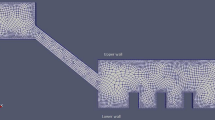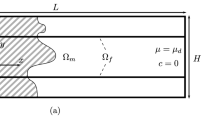Abstract
Erosion of sand or other granular material is a subject of utmost importance in several fields of practical interest, including industrial processes or environmental issues. Resulting from intricate interaction between the incident flow field and localized body forces responsible for the granular material cohesion, erosion is a particularly complex phenomenon. The present work addresses this problem, proposing a numerical method to compute the time evolution of a sand dune subjected to aeolian erosion, along with the associated entrainment and deposition fluxes. Turbulent fluid flow is computed through a three-dimensional Navier-Stokes solver based on a generalized coordinate system. A Lagrangian approach is adopted for tracking the trajectories of particles entrained in the saltation regime, thus allowing prediction of the corresponding deposition locations. Different models for saltation fluxes are tested, along with several formulations for the creeping-to-saltation flux ratio, creeping threshold and creeping distance. Comparison with results from wind tunnel experiments is very encouraging, stressing the relative importance of creeping in the erosion process for the presently studied conditions.













Similar content being viewed by others
References
Crowe CT, Sommerfeld M, Tsuji Y (1998) Multiphase flows with droplets and particles. CRC Press LLC, London
Fan L-S, Zhu C (1998) Principles of gas-solid flows. Cambridge University Press, Cambridge
Shao Y (2008) Physics and modelling of wind erosion, 2nd edn. Springer, Montreal
Pye K, Tsoar H (2009) Aeolian sand and sand dunes. Springer, Berlin
Bagnold RA (1941) The physics of blown sand and desert dunes. Methuen, London (reprinted, (1954) 1960; 2005, by Dover. Mineola, NY)
Werner BT (1995) Eolian dunes: computer simulations and attractor interpretation. Geology 23:1107–1110
Narteau C, Zhang D, Rozier O, Claudin P (2009) Setting the length and time scales of a cellular automaton dune model from the analysis of superimposed bed forms. J Geophys Res 114(F03006):1–18
Barchyn TE, Hugenholtz CH (2011) A new tool for modeling dune field evolution based on an accessible, GUI version of the Werner dune model. Geomorphology 138:415–419
Eastwood E, Nield J, Baas A, Kocurek G (2011) Modelling controls on aeolian dune-field pattern evolution. Sedimentology 58:1391–1406
Stam JMT (1997) On the modelling of two-dimensional aeolian dunes. Sedimentology 44:127–141
Kroy K, Sauermann G, Herrmann H (2002) Minimal model for sand dunes. Phys Rev Lett 88(5):3–6
Pischiutta M, Formaggia L, Nobile F (2011) Mathematical modelling for the evolution of aeolian dunes formed by a mixture of sands: entrainment-deposition formulation. Commun Appl Ind Math 2:1–21
Exner FM (1925) Über die wechselwirkung zwischen wasser und geschiebe in Flüssen (in German). Sitz Acad Wiss Wien Math Naturwiss Abt. 2a 134:165–203
Sauermann G, Kroy K, Herrmann H (2001) Continuum saltation model for sand dunes. Phys Rev E 64(3):1–10
Jackson PS, Hunt JCR (1975) Turbulent wind flow over a low hill. Q J R Meteorolog Soc 101:929–955
Kawamura R (1951) Study of sand movement by wind. Univ. Tokyo. Rep Inst Sci Technol 5:95–112 (in Japanese)
Lettau K, Lettau HH (1978) Experimental and micrometeorological field studies of dune migration. In: Lettau HH, Lettau K (eds) Exploring the world’s driest climates. Institute of Environmental Science Report 101, Center for Climatic Research, University of Wisconsin, Madison, WI, USA, pp 110–147
Wang Z, Zheng X-J (2004) Theoretical prediction of creep flux in aeolian sand transport. Powder Technol 139:123–128
Ferreira AD, Fino MRM (2012) A wind tunnel study of wind erosion and profile reshaping of transverse sand piles in tandem. Geomorphology 139(140):230–241
Patankar SV (1980) Numerical heat transfer and fluid flow. Hemisphere Publishing Corporation, Washington DC
Launder BE, Spalding DB (1974) The numerical computation of turbulent flows. Comput Meth Appl Mech Eng 3:269–289
Cebeci T, Bradshaw P (1997) Momentum transfer in boundary layers. Hemisphere Publishing Corporation, New York
Van Doormaal JP, Raithby GD (1984) Enhancements of the simple method for predicting incompressible fluid flows. Numer Heat Transfer 7:147–163
Lopes AMG, Sousa ACM, Viegas DX (1995) Numerical simulation of turbulent flow and fire propagation in complex terrain. Numer Heat Transfer, Part A 27:229–253
Anderson RS, Haff PK (1988) Simulation of eolian saltation. Science 241:820–823
Shao Y, Li A (199) Numerical modelling of saltation in the atmospheric surface layer. Bound-Lay Meteorol 91:199–225
Oliveira LA, Costa VAF, Baliga BR (2008) Numerical model for the prediction of dilute three-dimensional, turbulent fluid-particle flows, using a Lagrangian approach for particle tracking and a CVFEM for the carrier phase. Int J Numer Meth Fluids 58:473–491
Maxey MR, Riley JJ (1983) Equation of motion for a small rigid sphere in a nonuniform flow. Phys Fluids 26:883–889
Wallis GB (1969) One-dimensional two-phase flow. McGraw-Hill, New York
Oliveira LA, Costa VAF, Baliga BR (2002) A Lagrangian-Eulerian model of particle dispersion in a turbulent plane mixing layer. Int J Numer Meth Fluids 40:639–653
Gosman AD, Ionnides E (1981) Aspects of computer simulation of liquid fuelled combustors. AIAA Paper No 81–0323
Dong Z, Liu X, Wang H, Wang X (2003) Aeolian sand transport: a wind tunnel model. Sediment Geol 161:71–83
Bagnold RA (1956) The flow of cohesionless grains in fluids. Philos Trans R Soc Lond Ser A 249:235–297
Ferreira AD, Farimani A, Sousa ACM (2011) Numerical and experimental analysis of wind erosion on a sinusoidal pile. Environ Fluid Mech 11:167–181
Gillete DA, Passi R (1988) Modeling dust emission caused by wind erosion. J Geophys Res 93(D11):14233–14242
Marticorena B, Bergametti G (1995) Modeling the atmospheric dust cycle: 1. Design of a soil-derived dust emission scheme. J Geophys Res 100(D8):16415–16430
Shao Y (2004) Simplification of a dust emission scheme and comparison with data. J Geophys Res 109(D10):1–6
Andreotti B, Claudin P, Douady S (2002) Selection of dune shapes and velocities Part 1: dynamics of sand, wind and barchans. Eur Phys J B 28:321–339
Almeida MP, Parteli EJR, Andrade JS, Herrmann HJ (2008) Giant saltation on Mars. Proc Natl Acad Sci USA 105(17):6222–6226
Lancaster N, Nickling WG, Neuman CKM, Wyatt VE (1996) Sediment flux and airflow on the stoss slope of a barchan dune. Geomorphology 17:55–62
Durán O, Herrmann H (2006) Modelling of saturated sand flux. J Stat Mech: Theory Exp 7:P07011–P07011
Iversen JD, Rasmussen KR (1999) The effect of wind speed and bed slope on sand transport. Sedimentology 46:723–731
Nalpanis P, Hunt JCR, Barrett CF (1993) Saltating particles over flat beds. J Fluid Mech 251:661–685
Shao Y (2007) Physics and Modelling of Wind Erosion, 2nd edn. Springer, Berlin
Sherman DJ, Li B, Ellis JE, Farrell EJ, Maia LP, Granja H (2012) Recalibrating aeolian sand transport models. Earth Surf Process Landf. doi:10.1002/esp.3310
Wentworth CK (1922) A scale of grade and class terms for clastic sediments. J Geol 30:377–392
Author information
Authors and Affiliations
Corresponding author
Rights and permissions
About this article
Cite this article
Lopes, A.M.G., Oliveira, L.A., Ferreira, A.D. et al. Numerical simulation of sand dune erosion. Environ Fluid Mech 13, 145–168 (2013). https://doi.org/10.1007/s10652-012-9263-2
Received:
Accepted:
Published:
Issue Date:
DOI: https://doi.org/10.1007/s10652-012-9263-2




